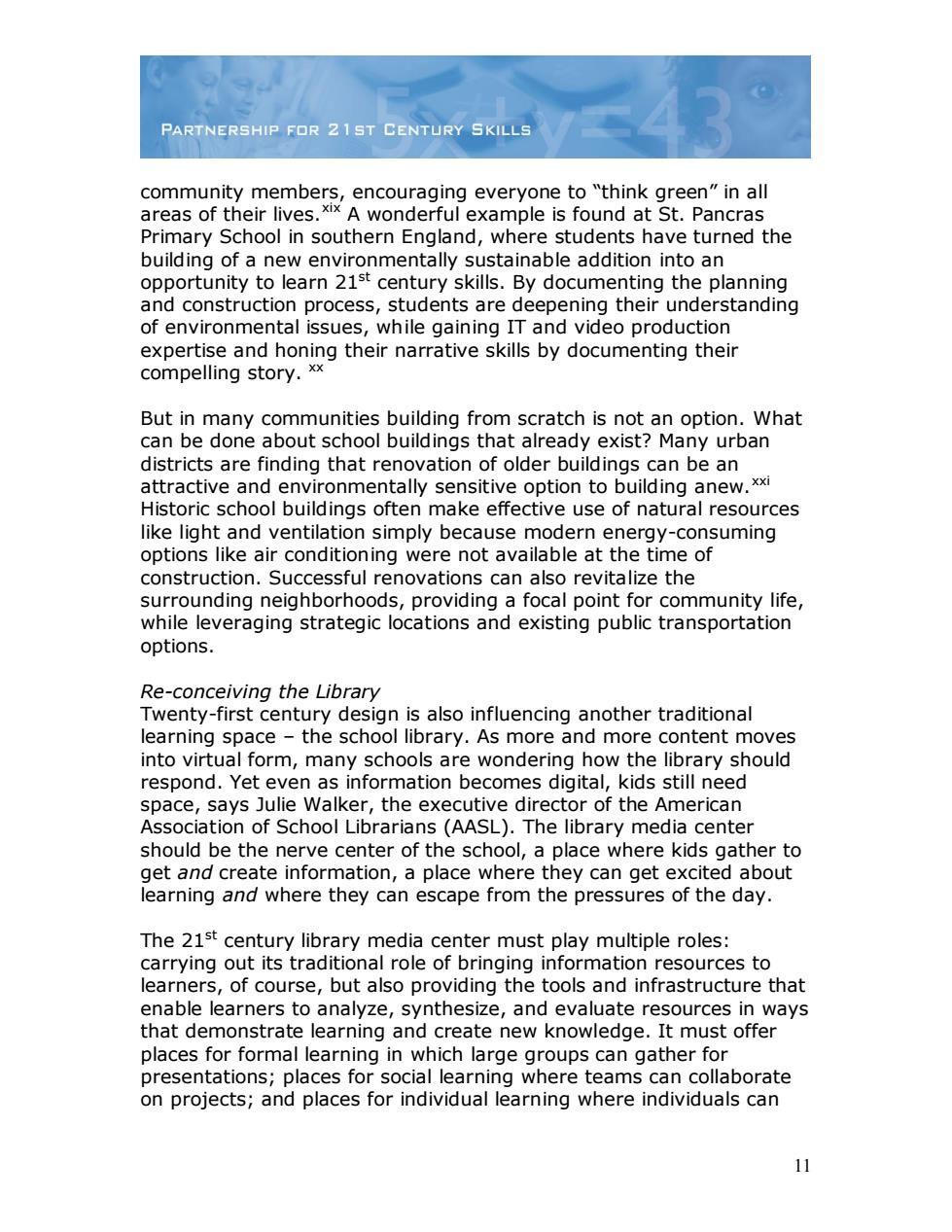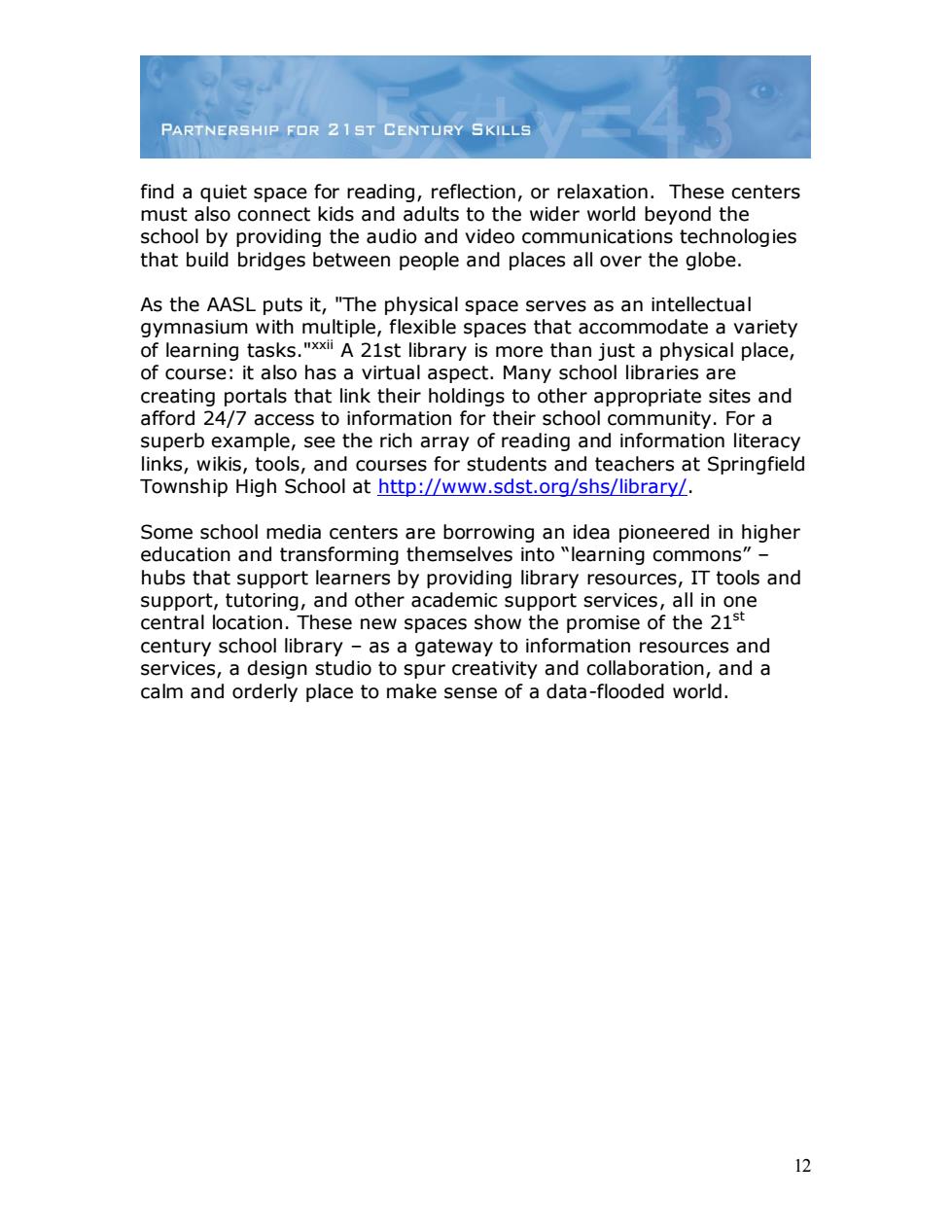
PARTNERSHIP FOR 21ST CENTURY SKILLS easotemewee encouraging everyone to "think green"in all A wonderful example is found at St.Pancr Primary Sc hool in southern England,where stu nts have turned the building of a new environmentally sustainable addition into an opportunity to learn 21st century skills.By documenting the planning and construction process,students are deepening their understanding of environmental issues,while gaining IT and video production their rrative skills by documenting their compelling story But in many communities building from scratch is not an option.What can be done about school buildings that already exist?Many urban districts are finding that renovation of older buildings can be an attractive and en nmentally sensitive option to building anew. ric school buildings often make effective use of natural I resources like light and ventilation simply because modern energy-consuming options like air conditioning were not available at the time of construction.Successful renovations can also revitalize the surroundina neiahborhoods.providina a focal point for community life while leveraging strategic locations and existing public transportation options. Re-conceiving the Library Twenty-first century desian is also influencina another traditional learning space-the school library.As more and more content moves into virt orm,many schools are wonde ibr ary should respond.Yet even as information becomes digital,kids still need space,says Julie Walker,the executive director of the American Association of School Librarians (AASL).The library media center should be the nerve center of the school.a place where kids aather to can get excited about escape rom the press es of the day. The 21st century library media center must play multiple roles: carrying out its traditional role of bringing information resources to learners,of course,but also providing the tools and infrastructure that enable learners to analyze,synthesize,and evaluate resources in ways that der non strate learning and c reate new knowledge.It must offer places for formal learning in which large groups can gather for presentations;places for social learning where teams can collaborate on projects;and places for individual learning where individuals can 11
11 community members, encouraging everyone to “think green” in all areas of their lives.xix A wonderful example is found at St. Pancras Primary School in southern England, where students have turned the building of a new environmentally sustainable addition into an opportunity to learn 21st century skills. By documenting the planning and construction process, students are deepening their understanding of environmental issues, while gaining IT and video production expertise and honing their narrative skills by documenting their compelling story. xx But in many communities building from scratch is not an option. What can be done about school buildings that already exist? Many urban districts are finding that renovation of older buildings can be an attractive and environmentally sensitive option to building anew.xxi Historic school buildings often make effective use of natural resources like light and ventilation simply because modern energy-consuming options like air conditioning were not available at the time of construction. Successful renovations can also revitalize the surrounding neighborhoods, providing a focal point for community life, while leveraging strategic locations and existing public transportation options. Re-conceiving the Library Twenty-first century design is also influencing another traditional learning space – the school library. As more and more content moves into virtual form, many schools are wondering how the library should respond. Yet even as information becomes digital, kids still need space, says Julie Walker, the executive director of the American Association of School Librarians (AASL). The library media center should be the nerve center of the school, a place where kids gather to get and create information, a place where they can get excited about learning and where they can escape from the pressures of the day. The 21st century library media center must play multiple roles: carrying out its traditional role of bringing information resources to learners, of course, but also providing the tools and infrastructure that enable learners to analyze, synthesize, and evaluate resources in ways that demonstrate learning and create new knowledge. It must offer places for formal learning in which large groups can gather for presentations; places for social learning where teams can collaborate on projects; and places for individual learning where individuals can

PARTNERSHIP FOR 21ST CENTURY SKILLS find a quiet space for reading,reflection,or relaxation.These centers must aiso connect kids and adults to the wider world beyond the school by providing the audio and video communications technologies that build bridges between people and places all over the globe. As the AASL puts it,"The physical space serves as an intellectual gymnasium with multiple,flexible spaces that accommodate a variety learning tasks A2ist library is more than just a physical place, of course:it also has a virtual aspect.Many school libraries are creating portals that link their holdings to other appropriate sites and afford 24/7 access to information for their school community.For a superb example,see the rich array of reading and information literacy links wikis and es for r stude tea e at Springfield Township High School at http://www.sdst.org/shs/library/. Some school media centers are borrowing an idea pioneered in higher education and transforming themselves into "learning commons"- hubs that su pport learners by providing library resources,IT tools and suppo tutoring,and academic support service l in central location.These new spaces show the promise of the century school library-as a gateway to information resources and services,a design studio to spur creativity and collaboration,and a calm and orderly place to make sense of a data-flooded world. 12
12 find a quiet space for reading, reflection, or relaxation. These centers must also connect kids and adults to the wider world beyond the school by providing the audio and video communications technologies that build bridges between people and places all over the globe. As the AASL puts it, "The physical space serves as an intellectual gymnasium with multiple, flexible spaces that accommodate a variety of learning tasks."xxii A 21st library is more than just a physical place, of course: it also has a virtual aspect. Many school libraries are creating portals that link their holdings to other appropriate sites and afford 24/7 access to information for their school community. For a superb example, see the rich array of reading and information literacy links, wikis, tools, and courses for students and teachers at Springfield Township High School at http://www.sdst.org/shs/library/. Some school media centers are borrowing an idea pioneered in higher education and transforming themselves into “learning commons” – hubs that support learners by providing library resources, IT tools and support, tutoring, and other academic support services, all in one central location. These new spaces show the promise of the 21st century school library – as a gateway to information resources and services, a design studio to spur creativity and collaboration, and a calm and orderly place to make sense of a data-flooded world